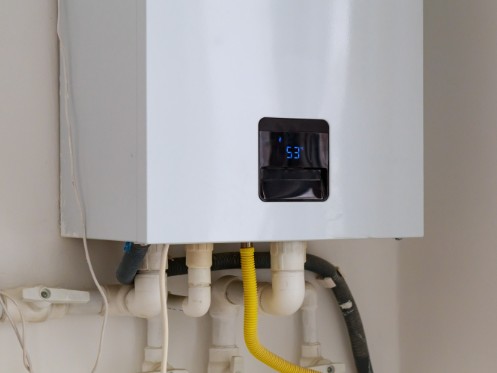Tankless water heaters are innovative appliances that provide hot water without a storage tank. One key advantage of tankless technology is its ability to eliminate standby heat loss. Standby heat loss occurs in traditional water heaters, where the stored hot water gradually loses heat over time, necessitating periodic reheating. This continuous energy consumption contributes to higher utility bills. On the other hand, tankless water heaters avoid this inefficiency by providing hot water only when needed, resulting in energy savings and reduced greenhouse gas emissions. As much as they offer numerous benefits, tankless water heaters also have limitations. Here are the common issues you will likely experience with tankless water heaters.
Installation Mistakes
Improper Sizing and Capacity Requirements
One common installation mistake that many homeowners make is choosing an undersized unit. An undersized unit contributes to inadequate hot water supply and unsatisfactory system performance. Conversely, opting for an oversized unit may seem ideal but can result in higher upfront costs and inefficiencies in the long run. Remember that different models of tankless water heaters have varying flow rates and heating capacities. As a result, it is essential to select one that aligns with your household’s needs so as to ensure optimal efficiency and performance. Investing the time and effort in choosing the right size during installation and seeking our professional help can save you from potential headaches and significant expenses.
Venting and Exhaust Considerations
Tankless water heaters produce combustion gases that need proper venting to ensure safe and efficient operation. Improper venting can lead to various problems, including carbon monoxide buildup, decreased efficiency and potential health hazards.
Fluctuating Water Temperatures
When the water flow rate is too low, your tankless heater may struggle to maintain a consistent temperature, leading to sudden shifts from hot to cold water. Additionally, if your tankless water heater is undersized for your household’s hot water demands, it will struggle to meet the desired water temperature levels, resulting in temperature fluctuations. Also, if the temperature sensor in your water heater is faulty or incorrectly calibrated, it may inaccurately control the heating process, causing irregularities in water temperature.
Mineral Buildup and Scale
Hard water contains high levels of dissolved minerals, like calcium and magnesium. If your home’s water supply is hard, dissolved minerals can accumulate inside your tankless unit’s heating elements and pipes over time. The buildup of dissolved minerals eventually forms layers of mineral deposits known as scale. When hard water passes through the heating system of your tankless water heater, the minerals present in the water tend to crystallize and adhere to the heating elements. Over time, these deposits can create a thick layer of scale, hindering the heating system’s ability to transfer heat effectively. As a result, the heater is forced to work harder to achieve the desired water temperature, leading to increased energy consumption and higher utility bills.
Ignition Failures
Ignition failure occurs when the water heater fails to ignite the burner. One common cause of ignition failure is the absence of gas. If the gas supply to the water heater is interrupted or turned off, the burner will not ignite. In such cases, you can inspect the gas line leading to the water heater and ensure it is open and free from blockages. You can also check if other gas appliances in the house are functioning correctly to identify whether the issue is specific to the water heater or a broader gas supply problem.
Another potential cause of ignition failure is a dirty or faulty igniter. Over time, an igniter may accumulate dirt, dust or soot, hindering its ability to generate a spark. In some cases, an error code displayed on the water heater’s control panel can provide valuable insights into the cause of the ignition failure. Error codes serve as diagnostic tools, indicating specific problems with the unit.
Overheating and Thermal Cutoff
Overheating occurs when the temperature within the unit exceeds safe operating limits, leading to potential damage or even safety hazards. Several factors can contribute to overheating, such as improper installation, insufficient water flow or failure of crucial components like sensors or controls.
While the thermal cutoff serves as a crucial safeguard, its activation often indicates an underlying problem. In some cases, it might be triggered due to a temporary issue, such as restricted water flow caused by a clogged filter or a partially open faucet. If the thermal cutoff is triggered frequently, it can indicate more serious issues, like a malfunctioning temperature sensor, a faulty control board or a failing heat exchanger.
Gas Supply Problems
Inadequate or interrupted gas supply can be caused by various factors, including a malfunctioning gas line, low gas pressure from the utility company or a blocked gas valve. When the gas supply is insufficient, the heater may produce a weak flame or even fail to ignite, leading to inadequate water heating. Additionally, a gas line clogged with debris or sediments can obstruct gas flow, causing potential safety hazards and decreasing the heater’s performance.
Combustion-Related Troubles
Proper combustion is essential for efficient heating and safety in tankless water heaters. Combustion issues can arise due to insufficient air supply to the burner, problems with the burner assembly or a faulty ignition system. Incomplete combustion leads to the production of a yellow or flickering flame, reducing the heater’s efficiency and generating harmful carbon monoxide (CO) gas. Carbon monoxide gas can pose serious health risks if not properly vented out of the living space.
Wiring and Connection Issues
Over time, vibrations and usage can cause electrical wires to become loose or damaged, leading to intermittent power supply or complete unit shutdown. Additionally, rodents and pests may chew through wires, causing disruptions in the electrical circuit. Scheduling regular inspections of the electrical connections and wiring, as well as prompt repairs, with Huft Home Services can help prevent these issues and ensure a stable electrical supply to your water heater.
Circuit-Breaker Tripping
If the circuit breaker in your tankless water heater tends to trip frequently, it may indicate that the circuit is overloaded or the circuit breaker is faulty. Overloading occurs when multiple high-power appliances draw excessive current from the same circuit, causing the circuit breaker to trip as a safety measure. By scheduling routine maintenance with us, you can rest assured that our technicians will check the electrical load on your circuit board and redistribute it to avoid electrical issues. We will also replace your circuit breaker if necessary.
Control Board and Sensor Failures
The control board is responsible for regulating various functions of the tankless water heater and monitoring safety features. If the control board malfunctions due to power surges or manufacturing defects, it can cause error codes to appear or the unit to stop working entirely. Similarly, if the water flow sensors or temperature sensors are faulty, it can lead to incorrect readings and trigger error codes. In such cases, you can count on our technicians to diagnose and replace the faulty components in your water heater.
Call the Experts
Huft Home Services offers a wide range of HVAC and plumbing services in Sacramento and surrounding areas. Our skilled technicians specialize in tankless water heater repairs and installations, HVAC maintenance, ductwork repairs and maintenance, as well as indoor air quality solutions. Due to our commitment to exceptional customer service and years of experience, you can rest assured that you will receive top-notch solutions for all your indoor comfort needs. Contact Huft Home Services today to keep your home safe, efficient and comfortable all year round.




